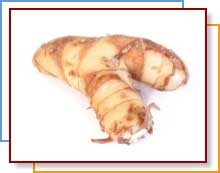Home | FOOD ARTICLES | Food Trivia | Today_in_Food_History | Food_History_Timeline | Recipes | Cooking_Tips | Food_Videos | Food_Quotes | Who’s_Who | Culinary_Schools_&_Tours | Food_Trivia_Quizzes | Food_Poems | Free_Magazines | Food_Festivals_and_Events
Food Articles, News & Features Section
FREE Magazines
and other Publications
Free Professional and Technical Research, White Papers, Case Studies, Magazines, and eBooks
GALANGAL
The rhizome (root) of galangal resembles ginger in taste and appearance. It is predominantly found in Asian markets and sold fresh, frozen, dried, or powdered. Galangal is also well known in European medieval cooking. Only a pinch of dried and powdered versions are typically needed.
Galangal is frequently used in fish and shellfish recipes in combination with garlic, ginger, chilli, and lemon.
Greater Galangal:
Orange-brown skin with pale yellow or white interior. Greater galangal can be found in sliced form or powder. Used as a flavoring throughout Indonesia, Malaysia, and parts of India.
Flavor: Not as pungent as lesser galangal.

Lesser Galangal:
This rhizome has a red-brown interior and fibrous texture. It can be founded as slices or powder. Lesser galangal comes from China where it is used as a medicinal herb, but it is now grown in Indonesia and regarded as a spice.
Flavor: Aromatic and pungent, peppery and ginger-like. Stronger, more medicinal taste than greater galangal.
Kaempferia Galangal:
Often identified as greater galangal. Red skin and white interior. Used as a flavoring in South East Asia.
Flavor: Medium in strength.
Different galangal varieties vary in their hotness and flavor. Flavor ranges from flowery to ginger-like to peppery cinnamon.
In addition to being used as a spice in cooking, galangal has been used in Asia and the Middle East in perfumes, snuffs, aphrodisiacs, and as flavors for condiments (including vinegar and beer), in teas in Germany and wines in Russia. Like ginger, galangal has been used for medicinal purposes to treat nausea, flatulence, and dyspepsia. Selection and Storage
Selection and Storage
When ripe, galangal should be ivory white and firm with very little separation between skin and flesh. Never buy galangal that is wrinkled or shriveled. Store refrigerated uncut and unwrapped for up to 3 weeks or, peel the root and place it in a jar of sherry and store it refrigerated for several months. Galangal can be frozen if tightly wrapped in foil.
Preparation
Galangal can be sliced and used to flavor soups and stews (remove before serving). It can also be mixed with lemon grass, chilies, shallots and garlic into a paste that can be used to flavor rice dishes. Galangal can also be mixed into a curry paste for similar purposes.
RELATED ARTICLES
Please feel free to link to any pages of FoodReference.com from your website.
For permission to use any of this content please E-mail: james@foodreference.com
All contents are copyright © 1990 - 2025 James T. Ehler and www.FoodReference.com unless otherwise noted. All rights reserved.
You may copy and use portions of this website for non-commercial, personal use only.
Any other use of these materials without prior written authorization is not very nice and violates the copyright.
Please take the time to request permission.
